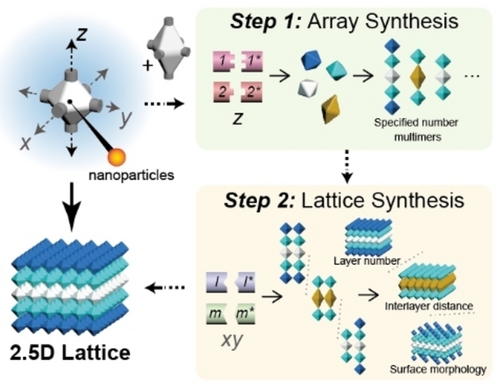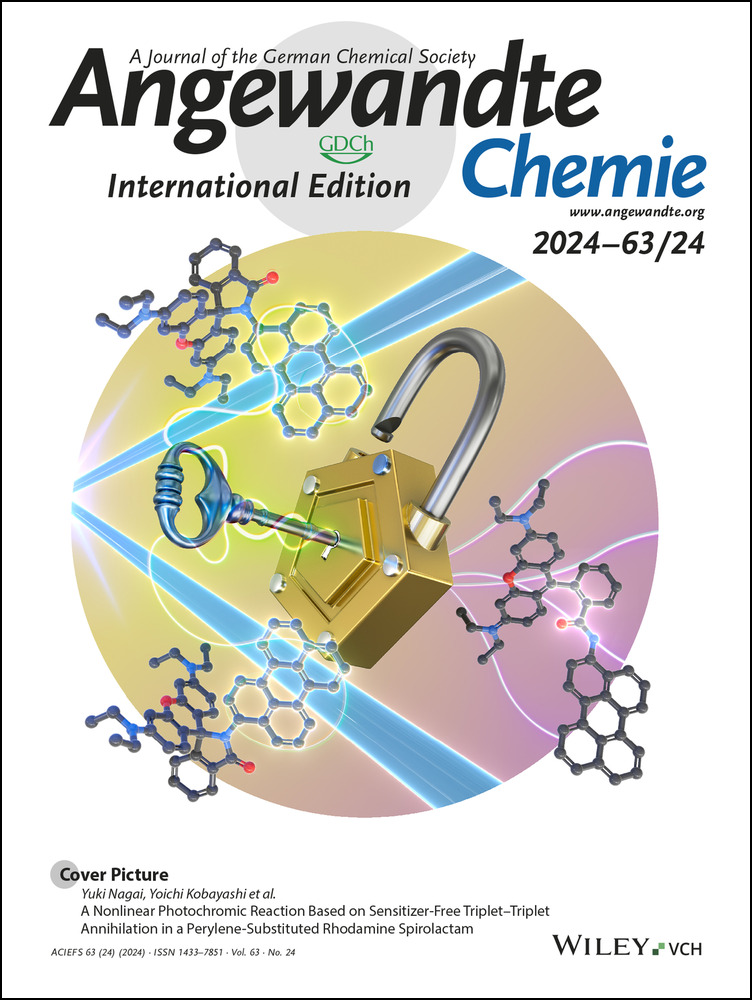Layer-Controllable “2.5D” DNA Origami Crystals Synthesized by a Hierarchical Assembly Strategy
Xiaolin Xie
College of Engineering and Applied Sciences, State Key Laboratory of Analytical Chemistry for Life Science, National Laboratory of Solid State Microstructures, Jiangsu Key Laboratory of Artificial Functional Materials, Chemistry and Biomedicine Innovation Center, Collaborative Innovation Center of Advanced Microstructures, Nanjing University, Nanjing, 210023 China
Search for more papers by this authorMin Ji
College of Engineering and Applied Sciences, State Key Laboratory of Analytical Chemistry for Life Science, National Laboratory of Solid State Microstructures, Jiangsu Key Laboratory of Artificial Functional Materials, Chemistry and Biomedicine Innovation Center, Collaborative Innovation Center of Advanced Microstructures, Nanjing University, Nanjing, 210023 China
Search for more papers by this authorXuehui Yan
College of Engineering and Applied Sciences, State Key Laboratory of Analytical Chemistry for Life Science, National Laboratory of Solid State Microstructures, Jiangsu Key Laboratory of Artificial Functional Materials, Chemistry and Biomedicine Innovation Center, Collaborative Innovation Center of Advanced Microstructures, Nanjing University, Nanjing, 210023 China
Search for more papers by this authorYifan Yu
College of Engineering and Applied Sciences, State Key Laboratory of Analytical Chemistry for Life Science, National Laboratory of Solid State Microstructures, Jiangsu Key Laboratory of Artificial Functional Materials, Chemistry and Biomedicine Innovation Center, Collaborative Innovation Center of Advanced Microstructures, Nanjing University, Nanjing, 210023 China
Search for more papers by this authorYong Wang
College of Engineering and Applied Sciences, State Key Laboratory of Analytical Chemistry for Life Science, National Laboratory of Solid State Microstructures, Jiangsu Key Laboratory of Artificial Functional Materials, Chemistry and Biomedicine Innovation Center, Collaborative Innovation Center of Advanced Microstructures, Nanjing University, Nanjing, 210023 China
Search for more papers by this authorNingning Ma
College of Engineering and Applied Sciences, State Key Laboratory of Analytical Chemistry for Life Science, National Laboratory of Solid State Microstructures, Jiangsu Key Laboratory of Artificial Functional Materials, Chemistry and Biomedicine Innovation Center, Collaborative Innovation Center of Advanced Microstructures, Nanjing University, Nanjing, 210023 China
Search for more papers by this authorProf. Dr. Hang Xing
Institute of Chemical Biology and Nanomedicine, State Key Laboratory of Chemo/Biosensing and Chemometrics, Hunan Provincial Key Laboratory of Biomacromolecular Chemical Biology, College of Chemistry and Chemical Engineering, Hunan University, Changsha, 410082 China
Search for more papers by this authorCorresponding Author
Prof. Dr. Ye Tian
College of Engineering and Applied Sciences, State Key Laboratory of Analytical Chemistry for Life Science, National Laboratory of Solid State Microstructures, Jiangsu Key Laboratory of Artificial Functional Materials, Chemistry and Biomedicine Innovation Center, Collaborative Innovation Center of Advanced Microstructures, Nanjing University, Nanjing, 210023 China
Search for more papers by this authorXiaolin Xie
College of Engineering and Applied Sciences, State Key Laboratory of Analytical Chemistry for Life Science, National Laboratory of Solid State Microstructures, Jiangsu Key Laboratory of Artificial Functional Materials, Chemistry and Biomedicine Innovation Center, Collaborative Innovation Center of Advanced Microstructures, Nanjing University, Nanjing, 210023 China
Search for more papers by this authorMin Ji
College of Engineering and Applied Sciences, State Key Laboratory of Analytical Chemistry for Life Science, National Laboratory of Solid State Microstructures, Jiangsu Key Laboratory of Artificial Functional Materials, Chemistry and Biomedicine Innovation Center, Collaborative Innovation Center of Advanced Microstructures, Nanjing University, Nanjing, 210023 China
Search for more papers by this authorXuehui Yan
College of Engineering and Applied Sciences, State Key Laboratory of Analytical Chemistry for Life Science, National Laboratory of Solid State Microstructures, Jiangsu Key Laboratory of Artificial Functional Materials, Chemistry and Biomedicine Innovation Center, Collaborative Innovation Center of Advanced Microstructures, Nanjing University, Nanjing, 210023 China
Search for more papers by this authorYifan Yu
College of Engineering and Applied Sciences, State Key Laboratory of Analytical Chemistry for Life Science, National Laboratory of Solid State Microstructures, Jiangsu Key Laboratory of Artificial Functional Materials, Chemistry and Biomedicine Innovation Center, Collaborative Innovation Center of Advanced Microstructures, Nanjing University, Nanjing, 210023 China
Search for more papers by this authorYong Wang
College of Engineering and Applied Sciences, State Key Laboratory of Analytical Chemistry for Life Science, National Laboratory of Solid State Microstructures, Jiangsu Key Laboratory of Artificial Functional Materials, Chemistry and Biomedicine Innovation Center, Collaborative Innovation Center of Advanced Microstructures, Nanjing University, Nanjing, 210023 China
Search for more papers by this authorNingning Ma
College of Engineering and Applied Sciences, State Key Laboratory of Analytical Chemistry for Life Science, National Laboratory of Solid State Microstructures, Jiangsu Key Laboratory of Artificial Functional Materials, Chemistry and Biomedicine Innovation Center, Collaborative Innovation Center of Advanced Microstructures, Nanjing University, Nanjing, 210023 China
Search for more papers by this authorProf. Dr. Hang Xing
Institute of Chemical Biology and Nanomedicine, State Key Laboratory of Chemo/Biosensing and Chemometrics, Hunan Provincial Key Laboratory of Biomacromolecular Chemical Biology, College of Chemistry and Chemical Engineering, Hunan University, Changsha, 410082 China
Search for more papers by this authorCorresponding Author
Prof. Dr. Ye Tian
College of Engineering and Applied Sciences, State Key Laboratory of Analytical Chemistry for Life Science, National Laboratory of Solid State Microstructures, Jiangsu Key Laboratory of Artificial Functional Materials, Chemistry and Biomedicine Innovation Center, Collaborative Innovation Center of Advanced Microstructures, Nanjing University, Nanjing, 210023 China
Search for more papers by this authorGraphical Abstract
Abstract
The finite periodic arrangement of functional nanomaterials on the two-dimensional scale enables the integration and enhancement of individual properties, making them an important research topic in the field of tuneable nanodevices. Although layer-controllable lattices such as graphene have been successfully synthesized, achieving similar control over colloidal nanoparticles remains a challenge. DNA origami technology has achieved remarkable breakthroughs in programmed nanoparticle assembly. Based on this technology, we proposed a hierarchical assembly strategy to construct a universal DNA origami platform with customized layer properties, which we called 2.5-dimensional (2.5D) DNA origami crystals. Methodologically, this strategy divides the assembly procedure into two steps: 1) array synthesis, and 2) lattice synthesis, which means that the layer properties, including layer number, interlayer distance, and surface morphology, can be flexibly customized based on the independent designs in each step. In practice, these synthesized 2.5D crystals not only pioneer the expansion of the DNA origami crystal library to a wider range of dimensions, but also highlight the technological potential for templating 2.5D colloidal nanomaterial lattices.
Conflict of interests
The authors declare no conflict of interest.
Supporting Information
As a service to our authors and readers, this journal provides supporting information supplied by the authors. Such materials are peer reviewed and may be re-organized for online delivery, but are not copy-edited or typeset. Technical support issues arising from supporting information (other than missing files) should be addressed to the authors.
| Filename | Description |
|---|---|
| anie202402312-sup-0001-misc_information.pdf7.5 MB | Supporting Information |
Please note: The publisher is not responsible for the content or functionality of any supporting information supplied by the authors. Any queries (other than missing content) should be directed to the corresponding author for the article.
References
- 1
- 1aP. Russell, Science 2003, 299, 358–362;
- 1bJ. Wang, J. B. Neaton, H. Zheng, V. Nagarajan, S. B. Ogale, B. Liu, D. Viehland, V. Vaithyanathan, D. G. Schlom, U. V. Waghmare, N. A. Spaldin, K. M. Rabe, M. Wuttig, R. Ramesh, Science 2003, 299, 1719–1722;
- 1cC. Markos, J. C. Travers, A. Abdolvand, B. J. Eggleton, O. Bang, Rev. Mod. Phys. 2017, 89, 045003;
- 1dC. Gong, X. Zhang, Science 2019, 363, eaav4450.
- 2
- 2aM. B. Ross, J. C. Ku, V. M. Vaccarezza, G. C. Schatz, C. A. Mirkin, Nat. Nanotechnol. 2015, 10, 453–458;
- 2bM. B. Ross, C. A. Mirkin, G. C. Schatz, J. Phys. Chem. C 2016, 120, 816–830.
- 3
- 3aX. Li, W. Cai, J. An, S. Kim, J. Nah, D. Yang, R. Piner, A. Velamakanni, I. Jung, E. Tutuc, S. K. Banerjee, L. Colombo, R. S. Ruoff, Science 2009, 324, 1312–1314;
- 3bY. H. Lee, X. Q. Zhang, W. Zhang, M. T. Chang, C. T. Lin, K. D. Chang, Y. C. Yu, J. T. Wang, C. S. Chang, L. J. Li, T. W. Lin, Adv. Mater. 2012, 24, 2320–2325.
- 4
- 4aK. S. Kim, Y. Zhao, H. Jang, S. Y. Lee, J. M. Kim, K. S. Kim, J. H. Ahn, P. Kim, J. Y. Choi, B. H. Hong, Nature 2009, 457, 706–710;
- 4bA. M. van der Zande, P. Y. Huang, D. A. Chenet, T. C. Berkelbach, Y. You, G. H. Lee, T. F. Heinz, D. R. Reichman, D. A. Muller, J. C. Hone, Nat. Mater. 2013, 12, 554–561;
- 4cJ. Jeon, S. K. Jang, S. M. Jeon, G. Yoo, Y. H. Jang, J. H. Park, S. Lee, Nanoscale 2015, 7, 1688–1695.
- 5
- 5aP. W. K. Rothemund, Nature 2006, 440, 297–302;
- 5bS. M. Douglas, H. Dietz, T. Liedl, B. Högberg, F. Graf, W. M. Shih, Nature 2009, 459, 414–418;
- 5cC. Zhou, X. Duan, N. Liu, Nat. Commun. 2015, 6, 8102;
- 5dC. Zhou, X. Duan, N. Liu, Acc. Chem. Res. 2017, 50, 2906–2914.
- 6
- 6aC. Zhou, Y. Zhang, Y. Dong, F. Wu, D. Wang, L. Xin, D. Liu, Adv. Mater. 2016, 28, 9819–9823;
- 6bJ. S. Kahn, Y. Xiong, J. Huang, O. Gang, JACS Au 2022, 2, 357–366;
- 6cS. T. Wang, B. Minevich, J. Liu, H. Zhang, D. Nykypanchuk, J. Byrnes, W. Liu, L. Bershadsky, Q. Liu, T. Wang, G. Ren, O. Gang, Nat. Commun. 2021, 12, 3702.
- 7
- 7aD. Han, S. Pal, J. Nangreave, Z. Deng, Y. Liu, H. Yan, Science 2011, 332, 342–346;
- 7bA. Kuzyk, R. Schreiber, Z. Fan, G. Pardatscher, E. M. Roller, A. Högele, F. C. Simmel, A. O. Govorov, T. Liedl, Nature 2012, 483, 311–314;
- 7cR. Veneziano, S. Ratanalert, K. Zhang, F. Zhang, H. Yan, W. Chiu, M. Bathe, Science 2016, 352, aaf4388;
- 7dN. Li, Y. Shang, R. Xu, Q. Jiang, J. Liu, L. Wang, Z. Cheng, B. Ding, J. Am. Chem. Soc. 2019, 141, 17968–17972;
- 7eG. Yao, F. Zhang, F. Wang, T. Peng, H. Liu, E. Poppleton, P. Šulc, S. Jiang, L. Liu, C. Gong, X. Jing, X. Liu, L. Wang, Y. Liu, C. Fan, H. Yan, Nat. Chem. 2020, 12, 1067–1075.
- 8
- 8aP. Wang, S. Gaitanaros, S. Lee, M. Bathe, W. M. Shih, Y. Ke, J. Am. Chem. Soc. 2016, 138, 7733–7740;
- 8bZ. Lin, H. Emamy, B. Minevich, Y. Xiong, S. Xiang, S. Kumar, Y. Ke, O. Gang, J. Am. Chem. Soc. 2020, 142, 17531–17542;
- 8cY. Li, W. Zhou, I. Tanriover, W. Hadibrata, B. E. Partridge, H. Lin, X. Hu, B. Lee, J. Liu, V. P. Dravid, K. Aydin, C. A. Mirkin, Nature 2022, 611, 695–701.
- 9
- 9aJ. Jin, Y. Xing, Y. Xi, X. Liu, T. Zhou, X. Ma, Z. Yang, S. Wang, D. Liu, Adv. Mater. 2013, 25, 4714–4717;
- 9bY. Li, R. Chen, B. Zhou, Y. Dong, D. Liu, Adv. Mater. 2024, 36, 2307129.
- 10
- 10aT. Zhang, C. Hartl, K. Frank, A. Heuer-Jungemann, S. Fischer, P. C. Nickels, B. Nickel, T. Liedl, Adv. Mater. 2018, 30, 1800273;
- 10bM. Ji, J. Liu, L. Dai, L. Wang, Y. Tian, J. Am. Chem. Soc. 2020, 142, 21336–21343;
- 10cM. Ji, Z. Zhou, W. Cao, N. Ma, W. Xu, Y. Tian, Sci. Adv. 2022, 8, eadc9755.
- 11Y. Tian, J. R. Lhermitte, L. Bai, T. Vo, H. L. Xin, H. Li, R. Li, M. Fukuto, K. G. Yager, J. S. Kahn, Y. Xiong, B. Minevich, S. K. Kumar, O. Gang, Nat. Mater. 2020, 19, 789–796.
- 12Y. Wang, L. Dai, Z. Ding, M. Ji, J. Liu, H. Xing, X. Liu, Y. Ke, C. Fan, P. Wang, Y. Tian, Nat. Commun. 2021, 12, 3011.
- 13M. Wang, L. Dai, J. Duan, Z. Ding, P. Wang, Z. Li, H. Xing, Y. Tian, Angew. Chem. Int. Ed. 2020, 59, 6389–6396.
- 14
- 14aX. Liu, F. Zhang, X. Jing, M. Pan, P. Liu, W. Li, B. Zhu, J. Li, H. Chen, L. Wang, J. Lin, Y. Liu, D. Zhao, H. Yan, C. Fan, Nature 2018, 559, 593–598;
- 14bL. Nguyen, M. Döblinger, T. Liedl, A. Heuer-Jungemann, Angew. Chem. Int. Ed. 2019, 58, 912–916.





